1. Overview
1.1 Plugin Name
- Sign Plugin
1.2 Appropriate Scenario
- Support http header to authorize
- Support http header and request body to authorize
1.3 Plugin functionality
- Process signature authentication of requests.
1.4 Plugin code
-
Core Module:
shenyu-plugin-sign -
Core Class:
org.apache.shenyu.plugin.sign.SignPlugin
1.5 Added Since Which shenyu version
- Since ShenYu 2.4.0
2. How to use plugin
2.1 Plugin-use procedure chart
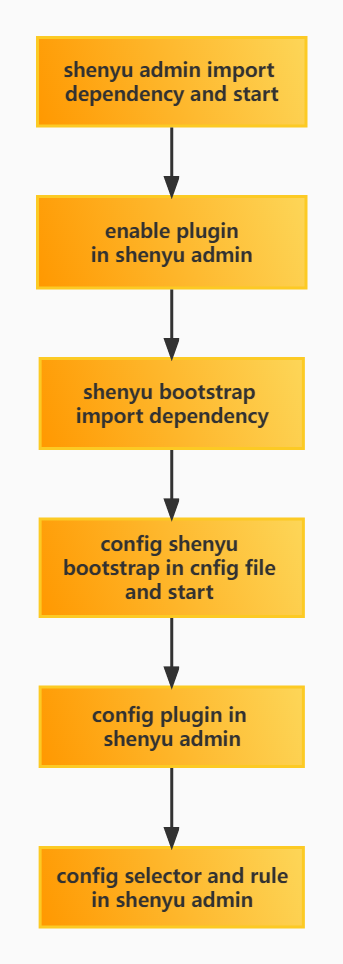
2.2 Import pom
- Introducing
signdependency in thepom.xmlfile of the gateway
<!-- apache shenyu sign plugin start-->
<dependency>
<groupId>org.apache.shenyu</groupId>
<artifactId>shenyu-spring-boot-starter-plugin-sign</artifactId>
<version>${project.version}</version>
</dependency>
<!-- apache shenyu sign plugin end-->
2.3 Enable plugin
- In
shenyu-admin--> BasicConfig --> Plugin -->signset to enable.
2.4 Config Plugin With Authorize
2.4.1 AK/SK Config
2.4.1.1 Explanation
- Manage and control the permissions of requests passing through the Apache ShenYu gateway.
- Generate
AK/SKand use it with theSignplugin to achieve precise authority control based on URI level.
2.4.1.2 Tutorial
First, we can add a piece of authentication information in BasicConfig - Authentication
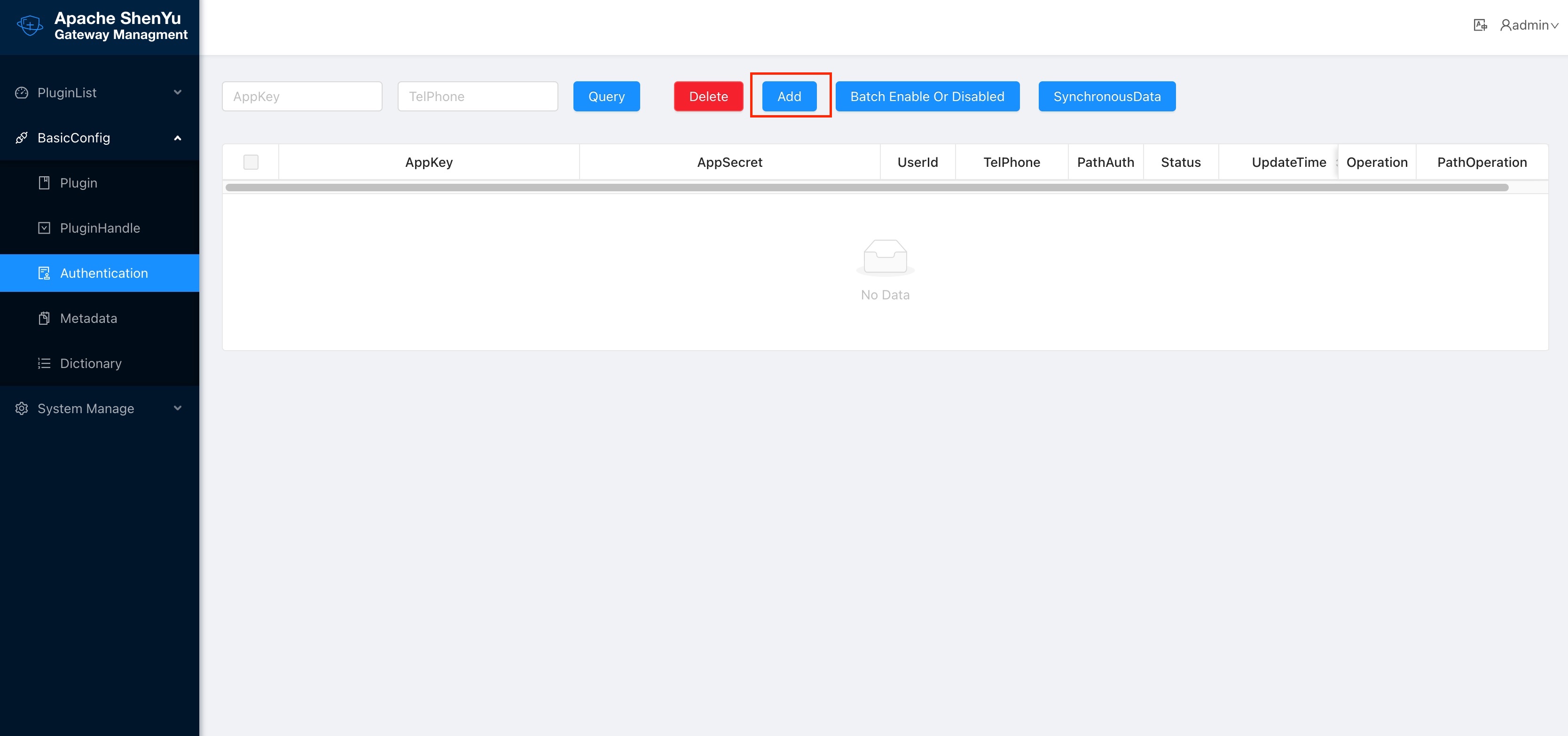
Then configure this authentication information
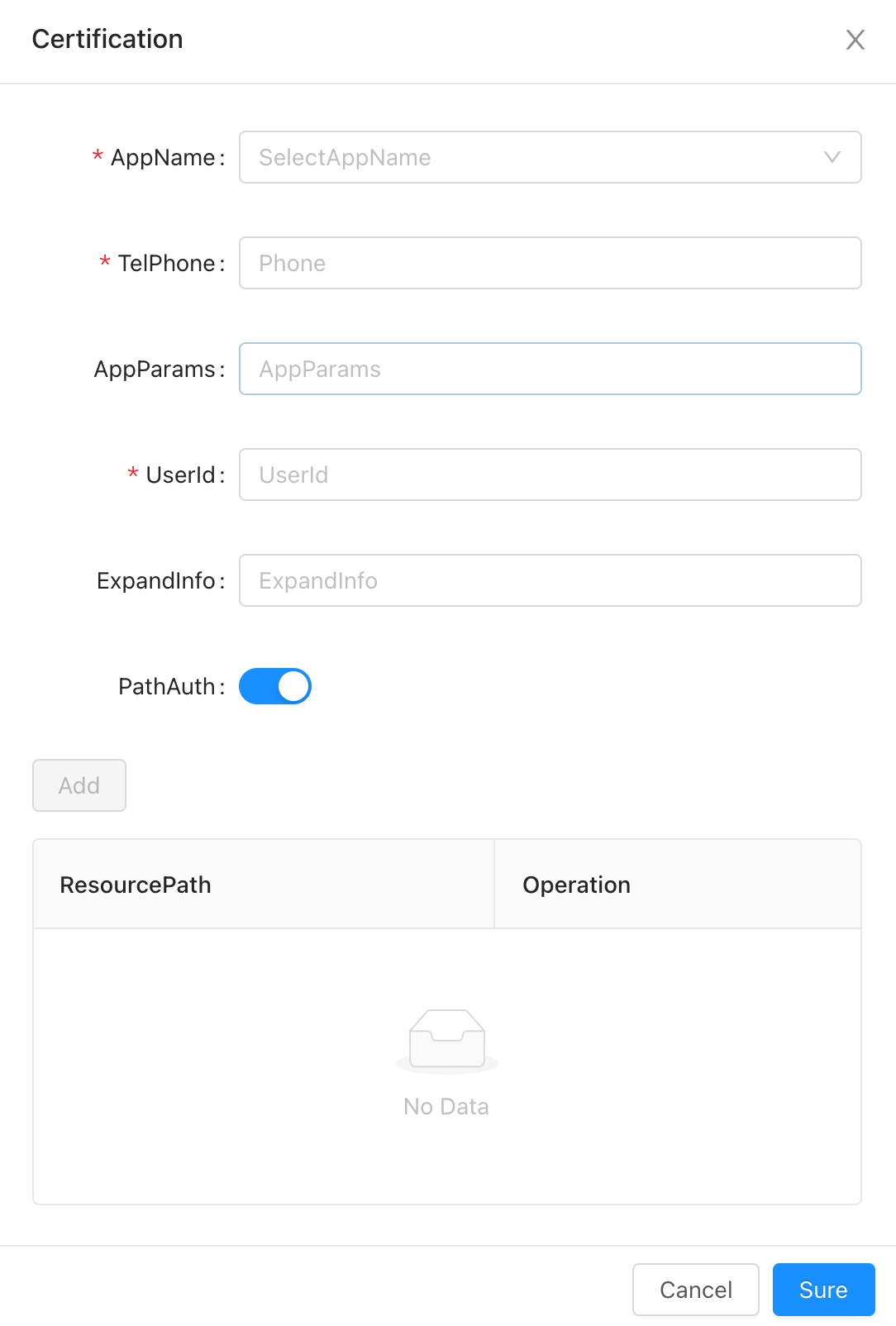
- AppName:The application name associated with this account, it can can fill in or choose (data comes from the application name configured in the Metadata).
- TelPhone:Telphone information.
- AppParams:When the requested context path is the same as the AppName,add this value to the header, the key is
appParam. - UserId:Give the user a name, just as an information record.
- ExpandInfo:Description of the account.
- PathAuth:After opening, the account only allows access to the resource path configured below.
- ResourcePath:Allow access to the resource path, support path matching,e.g.
/order/**.
After submit, a piece of authentication information is generated, which contains AppKey and AppSecret, which is the AK/SK in the Sign plugin.
Please refer to the detailed instructions of the Sign plugin: Sign Plugin.
2.4.1.3 PathOperation
For the created authentication information, you can click PathOperation at the end of a piece of authentication information.

- On the left is a list of configurable paths, and on the right is a list of paths that allow the account to access.
- Check the resource path, click the
>or<in the middle to move the checked data to the corresponding list. - In the list of configurable paths on the left, click "Editor" at the end of the account information line, and add them in the "Resource Path" in the pop-up box.
2.4.2 Implementation of Gateway Technology
- Adopt
AK/SKauthentication technical scheme. - Adopt authentication plug-in and Chain of Responsibility Pattern to realize.
- Take effect when the authentication plugin is enabled and all interfaces are configured for authentication.
2.4.3 Authentication Guide
-
Step 1:
AK/SKis assigned by the gateway. For example, theAKassigned to you is:1TEST123456781SK is: ` 506eeb535cf740d7a755cb49f4a1536' -
Step 2: Decide the gateway path you want to access, such as
/api/service/abc -
Step 3: Construct parameters (the following are general parameters)
| Field | Value | Description |
|---|---|---|
| timestamp | current timestamp(String) | The number of milliseconds of the current time(gateway will filter requests the before 5 minutes) |
| path | /api/service/abc | The path that you want to request(Modify by yourself according to your configuration of gateway) |
| version | 1.0.0 | 1.0.0 is a fixed string value |
Sort the above three field natually according to the key, then splice fields and fields, finally splice SK. The following is a code example.
2.4.3.1 Generate sign with request header
Step 1: First, construct a Map.
Map<String, String> map = Maps.newHashMapWithExpectedSize(3);
//timestamp is string format of millisecond. String.valueOf(LocalDateTime.now().toInstant(ZoneOffset.of("+8")).toEpochMilli())
map.put("timestamp","1571711067186"); // Value should be string format of milliseconds
map.put("path", "/api/service/abc");
map.put("version", "1.0.0");
Step 2: Sort the Keys naturally, then splice the key and values, and finally splice the SK assigned to you.
List<String> storedKeys = Arrays.stream(map.keySet()
.toArray(new String[]{}))
.sorted(Comparator.naturalOrder())
.collect(Collectors.toList());
final String sign = storedKeys.stream()
.map(key -> String.join("", key, params.get(key)))
.collect(Collectors.joining()).trim()
.concat("506EEB535CF740D7A755CB4B9F4A1536");
- The returned sign value should be:
path/api/service/abctimestamp1571711067186version1.0.0506EEB535CF740D7A755CB4B9F4A1536
Step 3: Md5 encryption and then capitalization.
DigestUtils.md5DigestAsHex(sign.getBytes()).toUpperCase()
- The final returned value is:
A021BF82BE342668B78CD9ADE593D683.
2.4.3.2 Generate sign with request header and request body
Step 1: First, construct a Map, and the map must save every request body parameters
Map<String, String> map = Maps.newHashMapWithExpectedSize(3);
//timestamp is string format of millisecond. String.valueOf(LocalDateTime.now().toInstant(ZoneOffset.of("+8")).toEpochMilli())
map.put("timestamp","1660659201000"); // Value should be string format of milliseconds
map.put("path", "/http/order/save");
map.put("version", "1.0.0");
// if your request body is:{"id":123,"name":"order"}
map.put("id", "1");
map.put("name", "order")
Step 2: Sort the Keys naturally, then splice the key and values, and finally splice the SK assigned to you.
List<String> storedKeys = Arrays.stream(map.keySet()
.toArray(new String[]{}))
.sorted(Comparator.naturalOrder())
.collect(Collectors.toList());
final String sign = storedKeys.stream()
.map(key -> String.join("", key, params.get(key)))
.collect(Collectors.joining()).trim()
.concat("2D47C325AE5B4A4C926C23FD4395C719");
- The returned sign value should be:
id123nameorderpath/http/order/savetimestamp1660659201000version1.0.02D47C325AE5B4A4C926C23FD4395C719
Step 3: Md5 encryption and then capitalization.
DigestUtils.md5DigestAsHex(sign.getBytes()).toUpperCase()
- The final returned value is:
35FE61C21F73E9AAFC46954C14F299D7.
2.4.4 Request GateWay
-
If your visited path is:
/api/service/abc. -
Address: http: domain name of gateway
/api/service/abc. -
Set
header,headerParameter:
| Field | Value | Description |
|---|---|---|
| timestamp | 1571711067186 | Timestamp when signing |
| appKey | 1TEST123456781 | The AK value assigned to you |
| sign | A90E66763793BDBC817CF3B52AAAC041 | The signature obtained above |
| version | 1.0.0 | 1.0.0 is a fixed value. |
-
The signature plugin will filter requests before
5minutes by default -
If the authentication fails, will return code
401, message may change.
{
"code": 401,
"message": "sign is not pass,Please check you sign algorithm!",
"data": null
}
2.4.5 Plugin Config
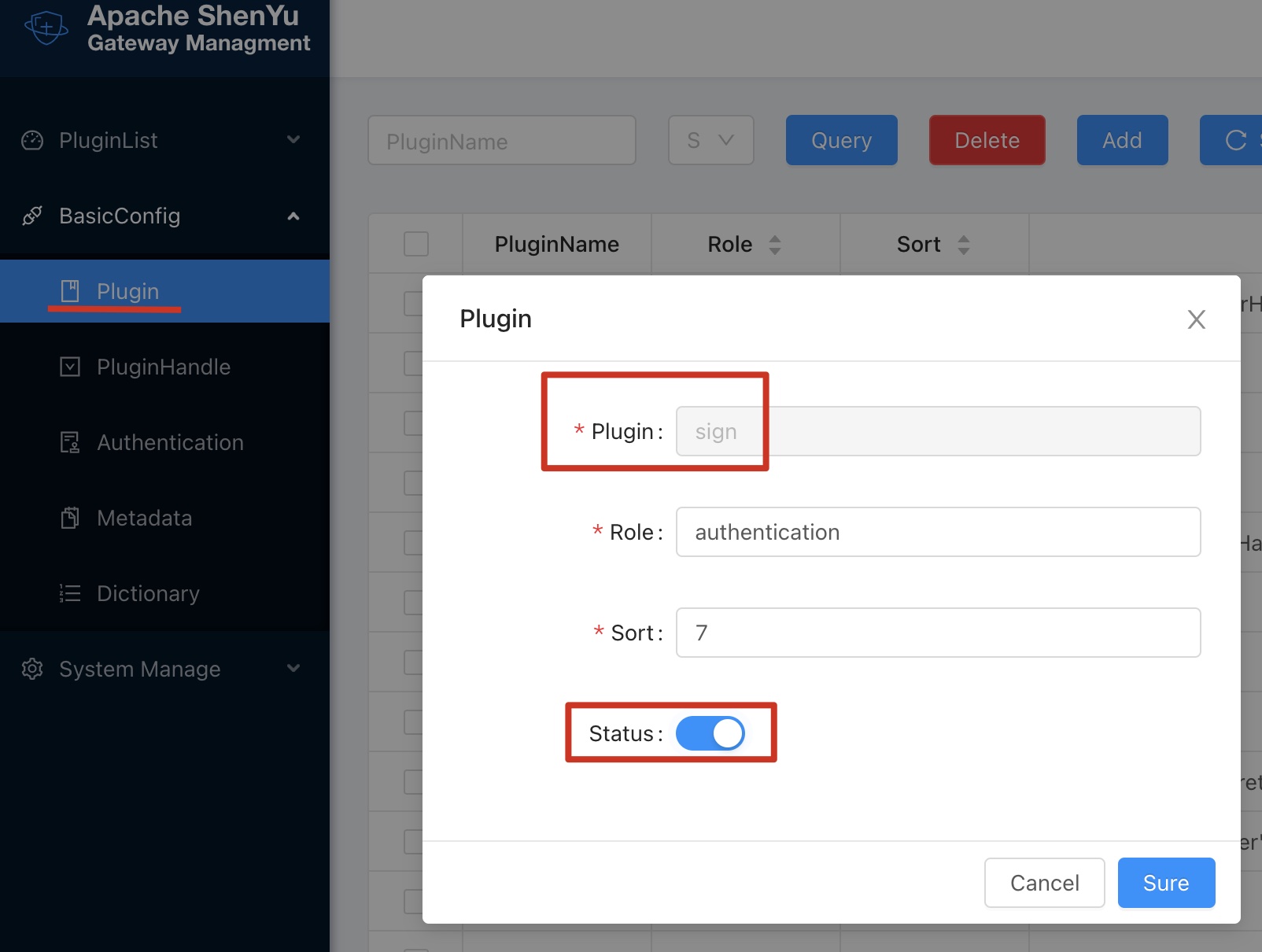
2.4.6 Selector Config

-
Only those matched requests can be authenticated by signature.
-
Selectors and rules, please refer to: Selector And Rule Config
2.4.7 Rule Config

- close(signRequestBody): generate signature with request header.
- open(signRequestBody): generate signature with request header and request body.
2.5 Examples
2.5.1 Verify api with sign plugin
2.5.1.1 Plugin Config

2.5.1.2 Selector Config
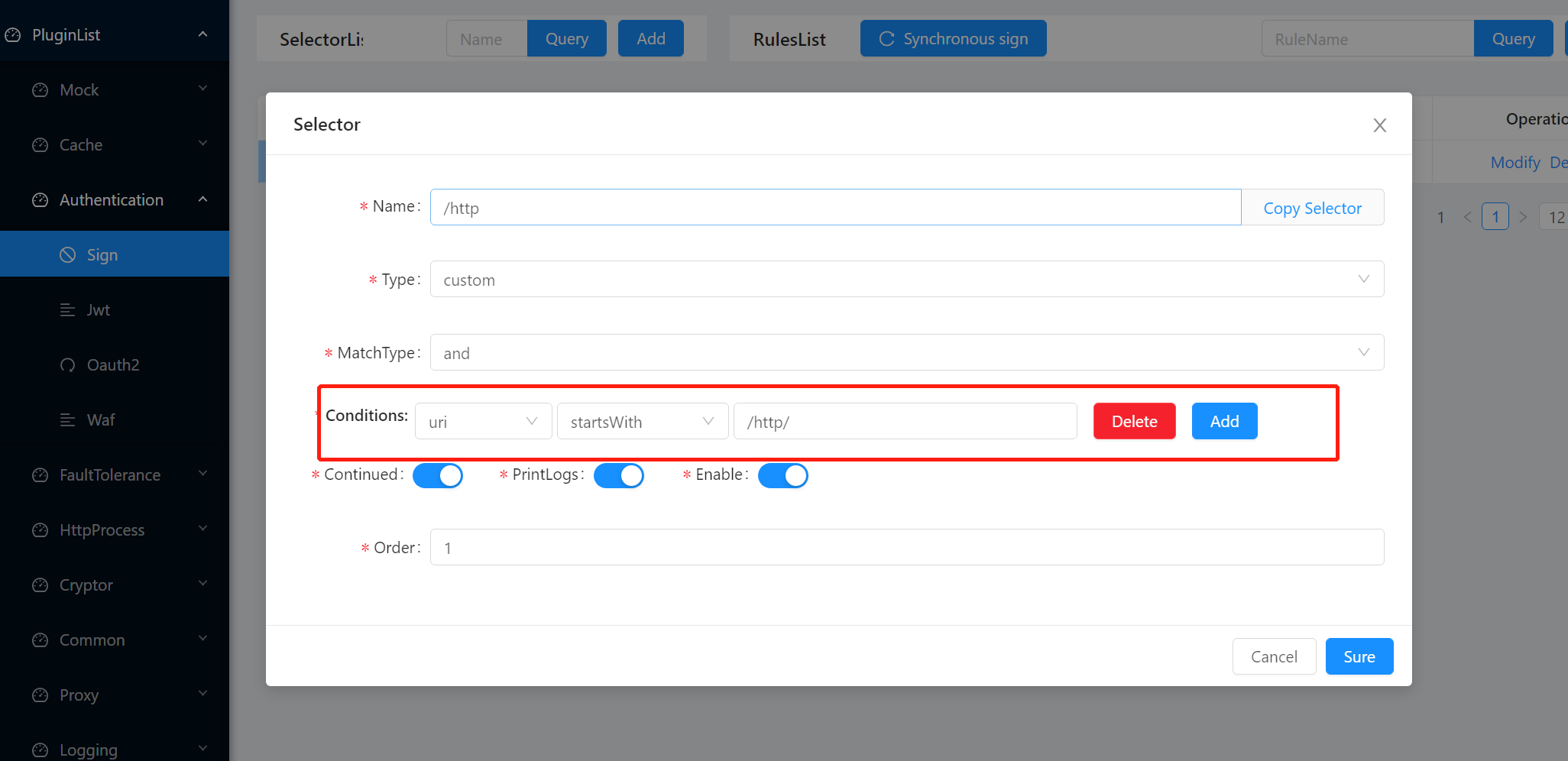
2.5.1.3 Rule Config
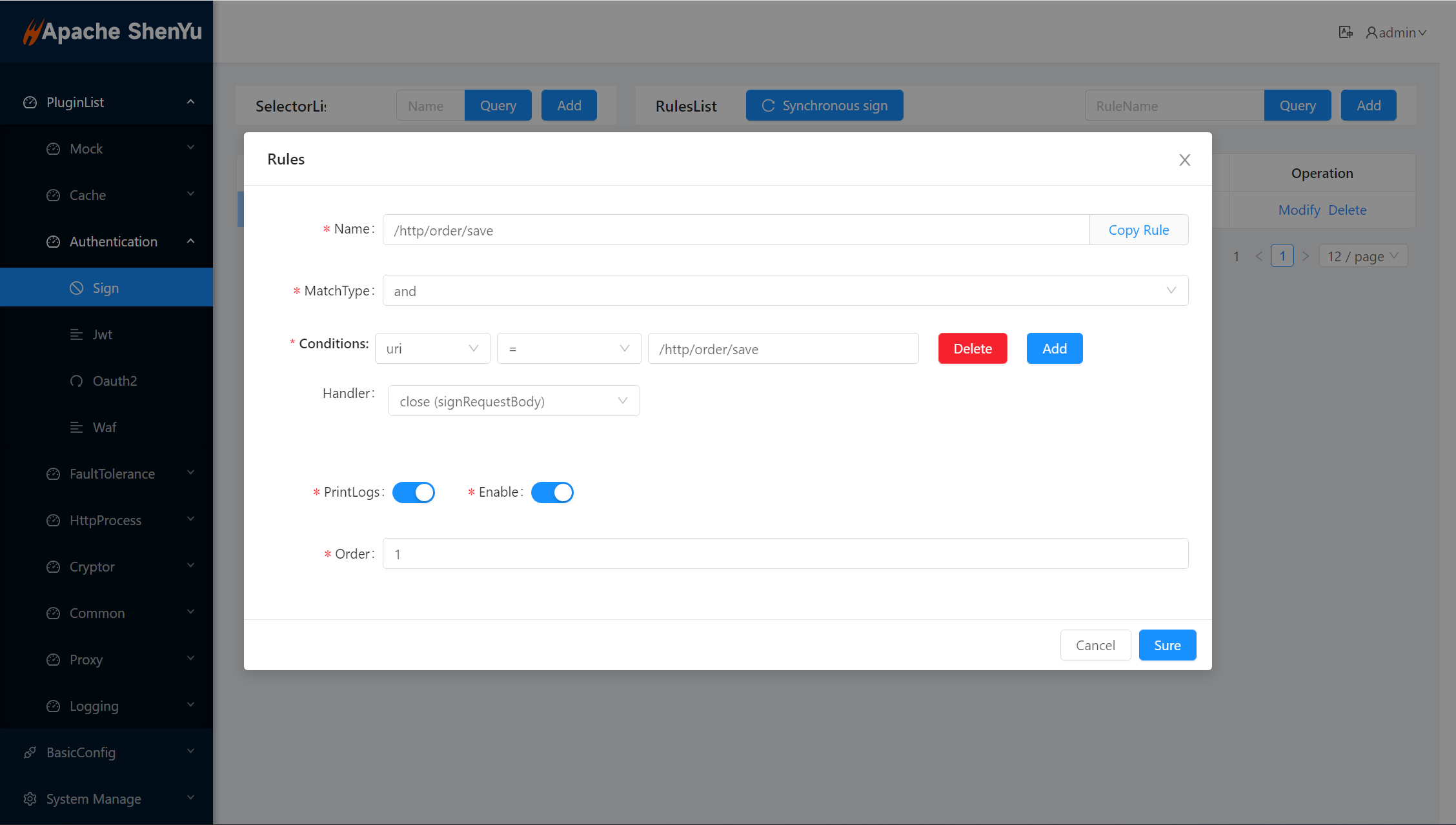
2.5.1.5 Add AppKey/SecretKey
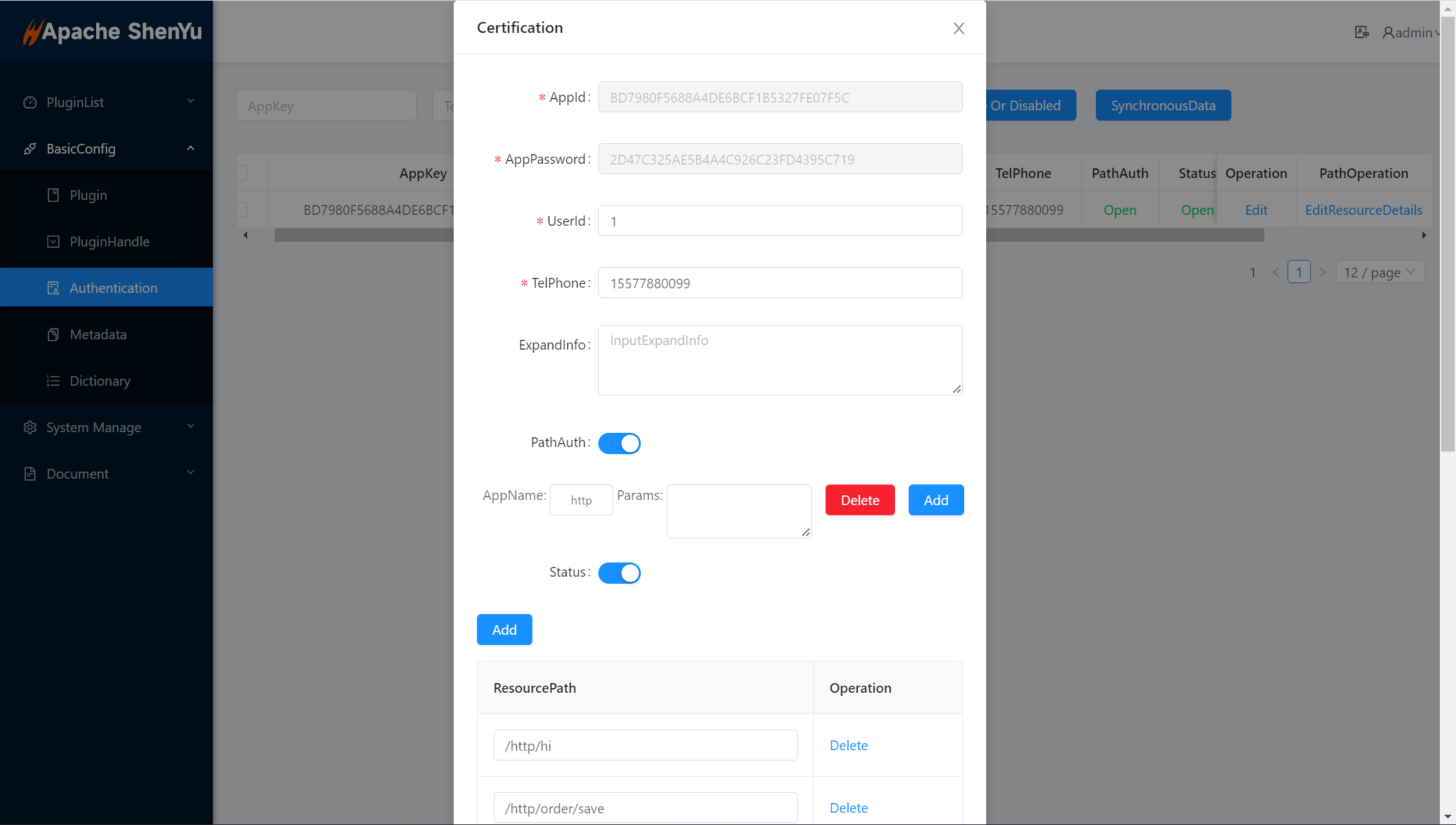
2.5.1.6 Request Service and check result
- build request params with
Authentication Guide,
public class Test1 {
public static void main(String[] args) {
Map<String, String> map = Maps.newHashMapWithExpectedSize(3);
//timestamp为毫秒数的字符串形式 String.valueOf(LocalDateTime.now().toInstant(ZoneOffset.of("+8")).toEpochMilli())
map.put("timestamp","1660658725000"); //值应该为毫秒数的字符串形式
map.put("path", "/http/order/save");
map.put("version", "1.0.0");
map.put("id", "123");
map.put("name", "order");
// map.put("body", "{\"id\":123,\"name\":\"order\"}");
List<String> storedKeys = Arrays.stream(map.keySet()
.toArray(new String[]{}))
.sorted(Comparator.naturalOrder())
.collect(Collectors.toList());
final String sign = storedKeys.stream()
.map(key -> String.join("", key, map.get(key)))
.collect(Collectors.joining()).trim()
.concat("2D47C325AE5B4A4C926C23FD4395C719");
System.out.println(sign);
System.out.println(DigestUtils.md5DigestAsHex(sign.getBytes()).toUpperCase());
}
}
- signature without body:
path/http/order/savetimestamp1571711067186version1.0.02D47C325AE5B4A4C926C23FD4395C719 - sign without body result is:
9696D3E549A6AEBE763CCC2C7952DDC1
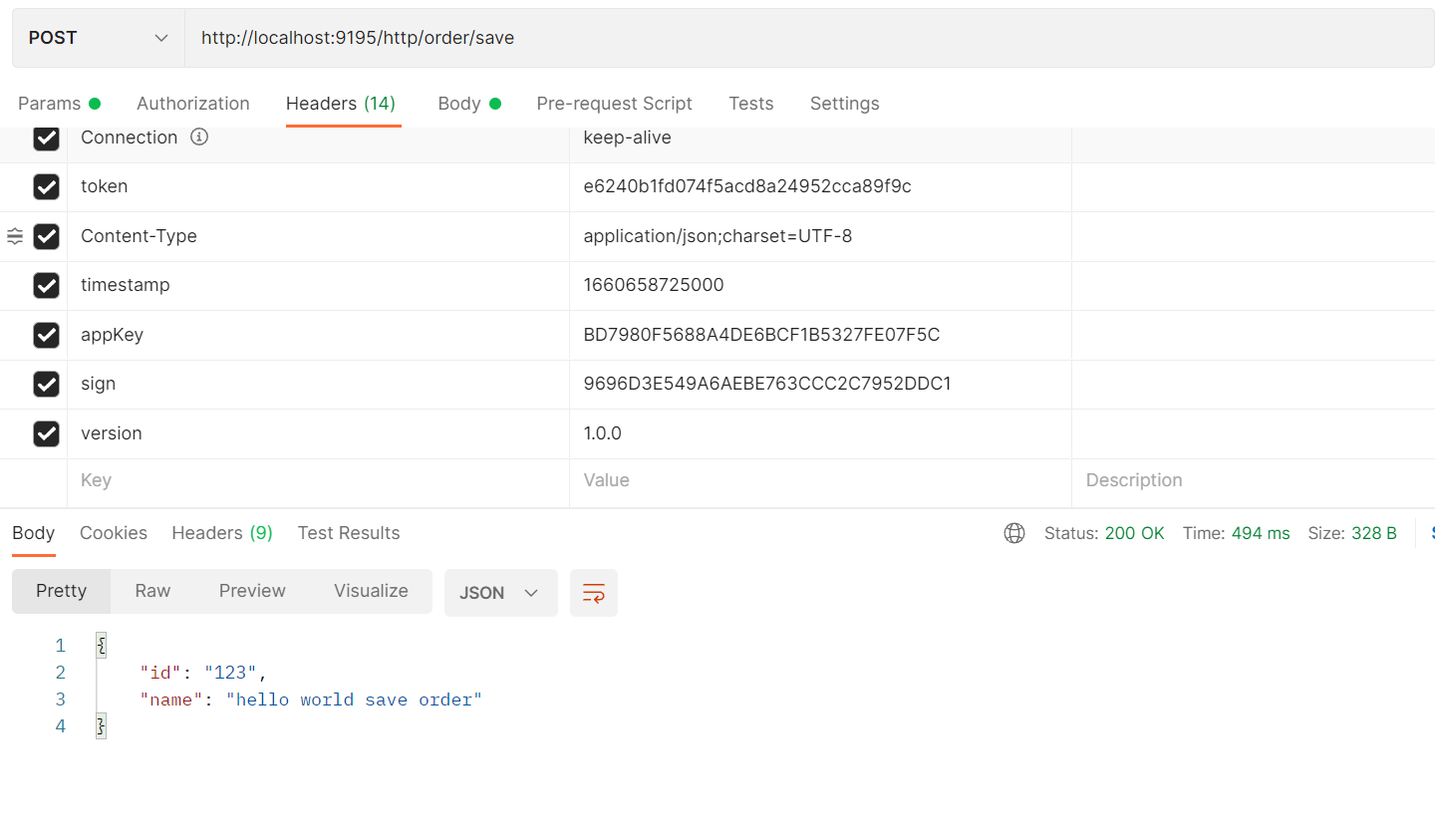
public class Test2 {
public static void main(String[] args) {
Map<String, String> map = Maps.newHashMapWithExpectedSize(3);
//timestamp为毫秒数的字符串形式 String.valueOf(LocalDateTime.now().toInstant(ZoneOffset.of("+8")).toEpochMilli())
map.put("timestamp","1660659201000"); //值应该为毫秒数的字符串形式
map.put("path", "/http/order/save");
map.put("version", "1.0.0");
List<String> storedKeys = Arrays.stream(map.keySet()
.toArray(new String[]{}))
.sorted(Comparator.naturalOrder())
.collect(Collectors.toList());
final String sign = storedKeys.stream()
.map(key -> String.join("", key, map.get(key)))
.collect(Collectors.joining()).trim()
.concat("2D47C325AE5B4A4C926C23FD4395C719");
System.out.println(sign);
System.out.println(DigestUtils.md5DigestAsHex(sign.getBytes()).toUpperCase());
}
}
*signature with body:id123nameorderpath/http/order/savetimestamp1660659201000version1.0.02D47C325AE5B4A4C926C23FD4395C719
*sign with body result is:35FE61C21F73E9AAFC46954C14F299D7
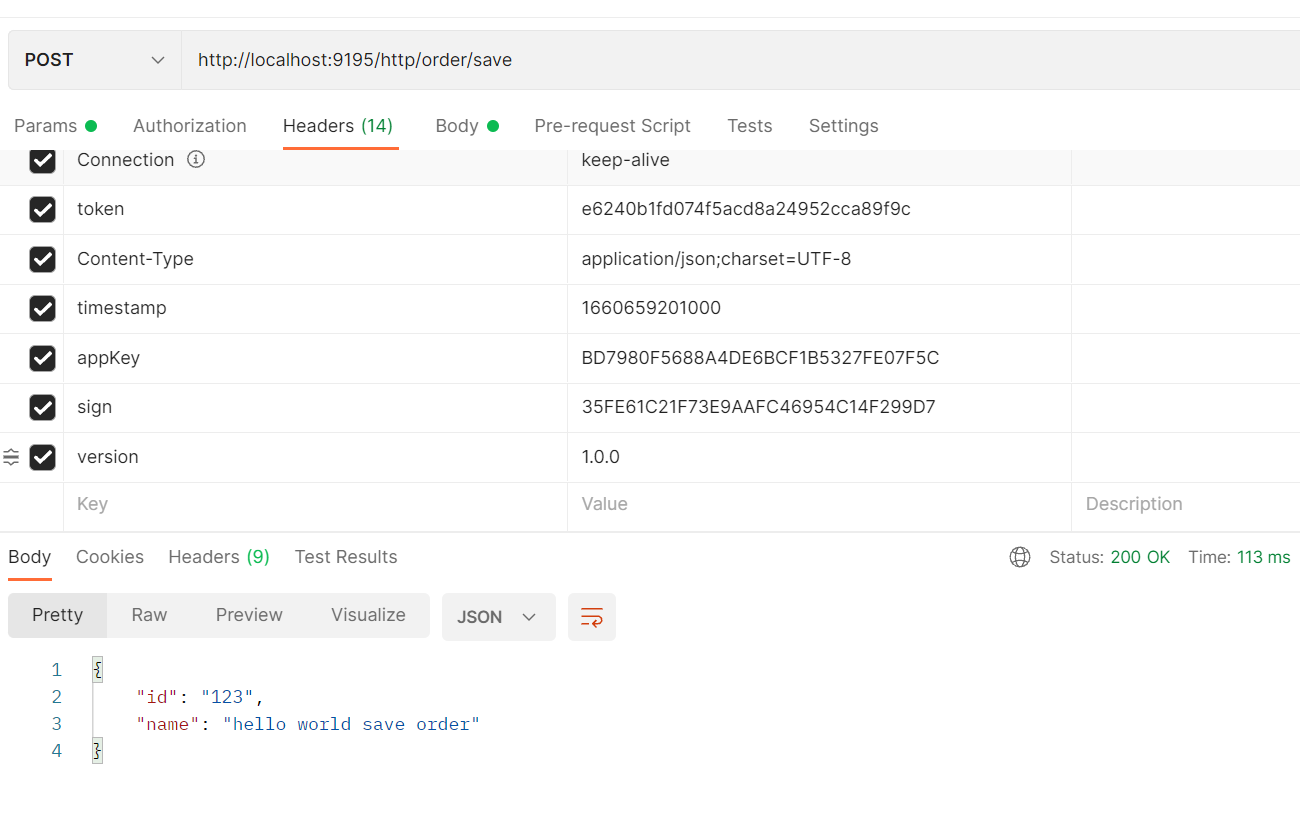
3. How to disable plugin
- In
shenyu-admin--> BasicConfig --> Plugin -->signset to disabled.
4. Extension
- Please refer to: dev-sign.